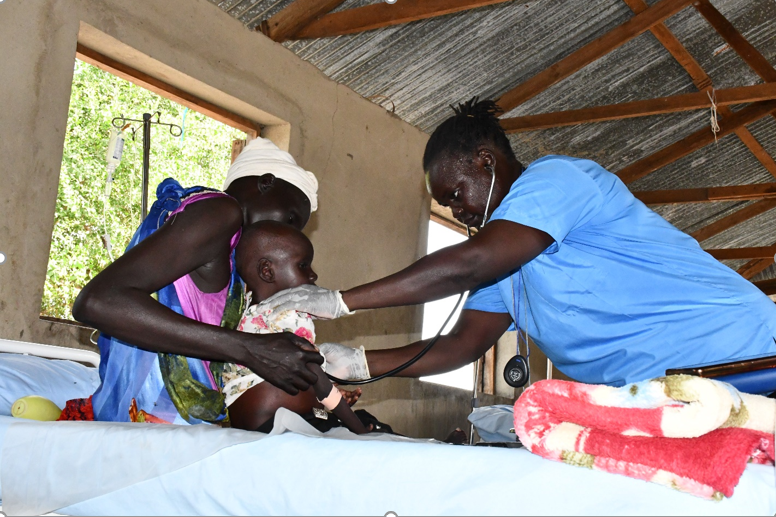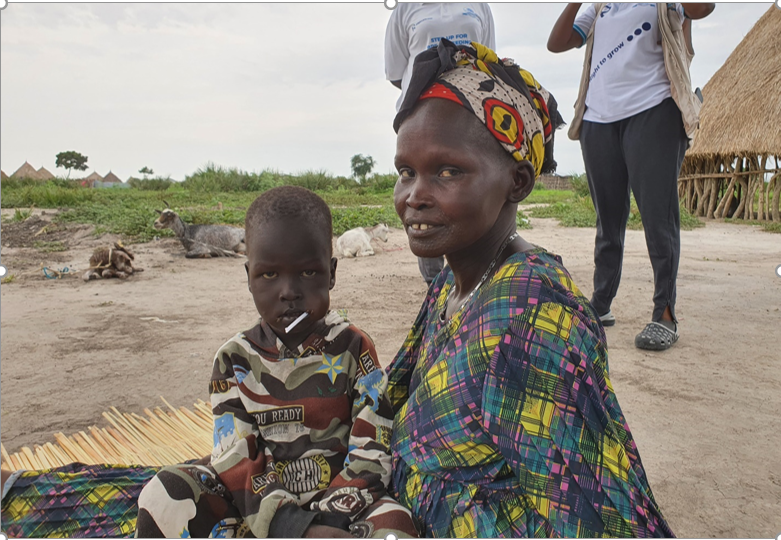
Grace Akumu, clinical officer at Rubkuay Primary Health Care Center takes temperature of newly admitted baby Nyaguande Malual (Photo: Atem James).
Mayendit – a county of more than 100,000 people in southern Unity State – is very much a hunger zone. Although it is in an oil-rich state, hunger bites every household, according to humanitarian data.
Inside an iron-roofed malnutrition ward of a UNIDOR-funded Primary Health Care Center (PHCC) in Rubkuay Payam, sit a dozen mothers next to malnourished children.
One of them is Nyanget Gai, wearing an anxious look as she gently nurses her sick daughter, Nyaguande who had just been admitted as one of the severest cases of malnutrition.
Ms Gai says she arrived from a nearby village to seek help at the facility after the 6-year-old girl could no longer eat any solid food for days.
“The problem is in her stomach, she has diarrhea, and she has been vomiting non-stop. When I came here this morning, the doctor told me the child is malnourished and has malaria that is what the doctor told me about the child,” Nyanget said through an interpretor.
Although Nyaguande ages 6 years, she has gone through a string of childhood ailments and had never been too strong to walk.
Nyanget had been told her daughter was suffering from a severe acute malnutrition and malaria and will require weeks of treatment and special care before she could recover fully.
Mayendit has not been spared from South Sudan’s man-made and natural calamities.
The impact of communal and political conflicts, coupled with an apocalyptic flooding which first struck the area in 2020, have destroyed livelihoods and left this rural population in unimaginable condition.
Since then, the area has remained poverty-stricken, with children under five years being extremely malnourished – and their chances of survival increasingly lessening every day as diseases, poor hygiene and floods continue to rage on.
This dire humanitarian situation has translated into a growing malnutrition crisis among children, pregnant and lactating mothers.
The level of hunger here in Mayendit and other parts of Unity State reflects a similar situation elsewhere in the country, where more than 6 million people are at risk of hunger, according to the Integrated Food Security Phase Classification (IPC) report released late in 2022.
In that assessment, Unity State, Jonglei State, and Greater Pibor Administrative Area, among others, were projected to be the worst affected. Leer and Mayendit counties in the far south of the oil-rich state were also said to be among the hardest hit.
Rubkuay is one of the 13 payams of Mayendit County, which has been spared by flooding this year. However, around 15,000 of its inhabitants still depend on food aid provided by humanitarian organizations.
People here used to grow grains and trade cattle as their source of income, but as a result of recurrent conflict and severe flooding, farming has significantly reduced over the years, with only a few households cultivating maize around their homesteads.
Being the only “Stabilization Center” where critical malnutrition cases are treated in the whole of the county, Rubkuay PHCC facility receives more than 30 severe cases of malnutrition among children and mothers every month.
Supported through the Right to Grow Project (R2G), a five-year consortium of seven national and international organizations, providing health, nutrition and food security among others, Rubkuay PHCC has become a lifeline for mothers and children battling malnutrition.
As part of the consortium, Universal Intervention and Development Organization or UNIDOR, a national NGO, runs nutrition and health program in Rubkuay PHCC and 11 other facilities located in the remote villages across the county with support from Save the Children and UNICEF.
As the center receives referrals from surrounding villages, it is not well-equipped and lacks essential facilities such as cold-chains and enough beds for admission and critical care.
Nevertheless, Grace Akumu, a clinical officer says the facility is the only hope for mothers who wade through flood waters from all corners of the county to come and save their children from malnutrition.
Ms. Akumu, however, laments that the facility has only four beds, where on worse days, they are forced to admit patients on the floor and give them mats to sleep on.
“I may receive one or two (cases of malnutrition) per day but sometimes it happens that in a day I receive up to seven patients which is a very high rate for a stabilization center like the one for Rubkuay,” she said, pointing at the mats spread between four beds in the admission ward which also serves as the store for drugs and laboratory at the same time.
“Sometimes in a month, I may receive 29 to 30 but the capacity of the of stabilization center is low and currently we only have four beds and when the number of patients increase, we use the mats and blankets (as admission beds) just to save lives otherwise this room can take more beds,” Grace says.

For the past three years, Grace has been receiving mothers and carers with children at their worst stage of malnutrition. With dedication, her team of nurses and herself have been able to restore the hope of these once hopeless mothers.
One such grateful carer is the grandmother of baby Dungdit Mabil. Months ago, she took her grandson – who was “only bones and skin” to the Stabilization Center. He was severely wasted and had wounds all over his head and back. For Grace and her colleagues, this case was the first to arrive in such a bad condition. He was about three years old.
But the health workers were to witness another bizarre situation that day. As Ms Grace attended to the baby, his grandma mysteriously disappeared from the facility. Workers at the facility searched everywhere for the woman but she was nowhere to be found and for the next seven days, Grace and her colleagues treated and took care of the abandoned baby.
The missing grandma would later sent a 12-year-old auntie of Dungdit to stay with him while she provide for seven other children at home.
This past week, UNIDOR visited her homestead located a few hundred meters away from Rubkuay PHCC. Noticing the approaching visitors, a happy and playful baby Dungdit recognizes Grace and clang to her. It has been a while since he was discharged from the stabilization center but baby Dungdit has not forgotten MS Grace.
Few minutes later, his grandmother, Nyawech Loang Gai arrives from the market where she works a tea seller.
She might have acted absurdly by abandoning Dungdit at the facility for days then but the grandma is now thankful for her grandson is alive.
“He is a happy boy now, he is learning to take care of the goats but when I took him to the facility he had lost weight and was just bones and had no muscles, no flesh. He was only bones and skin but since he was treated he never had any problem again,” says Nyawech.
Further east, about 10 kilometers away from Rubkuay, is Tutnyang Primary Health Care Unit (PHCU) supported by UNIDOR, in Tutnyang Payam. This facility, unlike Rubkuay PHCC, is much smaller but receives an even higher number of patients suffering malnutrition. This past month alone, the facility treated at least 30 cases.
One of them, is 2 and half year-old Nyanaath Phar Jaal. Her mother Nyalang Gatluak, 27, says she had recently returned from Khartoum, Sudan following outbreak of fighting there, when her daughter fell sick.
Suffering from diarrhea and fever, she says, her daughter’s condition changed from bad to worse and by the time she took her to Tutnyang PHCU, she was severely wasted.
After being admitted on nutrition programme for few weeks, she regained her health.
“She has now recovered. She was seriously sick before, but after I took her to the hospital, God has shown a way and her health has now improved after she was admitted for nutrition. When I took her to the hospital in June, she had fever and diarrhea, but after she was treated and given plumpy nuts, she has now recovered,” Nyalang says.
For years, UNIDOR and partners have been responding to the malnutrition crisis the usual way; treating the sick until they are well and discharging them, while hoping for reduction in the epidemic but the opposite has always been the result.
This is because locals were either not aware of their responsibility or were reluctantly involved in the fight against malnutrition.
But after the inclusion of advocacy in the intervention programme and through various trainings and engagements, locals have taken upon themselves to ways to fight malnutrition using locally available means and resources.
They now have “Kitchen Gardens” where vegetables are planted to use as part of the diet in addition to meat, fish and grains, says John Gatwech, the County Health Director for Mayendit.
“When you bring your child to the facility for treatment for malnutrition, the NGOs giving malnutrition services tell you what other different food you can feed the child with.
“They have also been training beneficiaries to cultivate their kitchen gardens and plant vegetables. People used to feed children with only cow milk (as supplementary food) but nowadays they mix all different food including greens, fish, meat and beans in their diet and that is why malnutrition has reduced,” he says.
Caroline Mbaya, the nutrition programme manager for UNIDOR says the advocacy and engagement interventions have made strides in the fight against malnutrition and have gone a long way in rallying the communities to fight the disease.
She says before 2021, when the advocacy programme began, the communities were reluctantly involved in addressing child wasting.
“We would do focus groups discussions and even go to other civil society organizations in the county to do inter-sectoral discussions on how we can improve nutrition in the county but they were demands,” she says.
“People were expecting token of appreciations, maybe refreshments and stuff like that, so, it has taken time for us to have the community accept that it is their responsibility and now accepting to do these FGDs (Focus Group Discussions) without so demands and now the authorities are working with us without expectations,” she further says.
According to the latest IPC report, child malnutrition cases have increased from 2.0 million to 2.2 million, with Jonglei State contributing the highest number of the cases in 2023.
This has led to increasing child vulnerability with more than 4.9 million children affected this year.
The Right2Grow Project is a nutritional programme being implemented by Save the Children and 7 other developmental and humanitarian organizations.
They include four national NGOs; Community Initiative For Development Organization (CIDO), Universal Intervention and Development Organization (UNIDOR), Support For Peace and Education Development Programme (SPEDP) and Child Rights Coalition (CRC).
The other NGOs include the World Vision, Action against Hunger and Centre for Economic Governance and Accountability in Africa (CEGAA).
Support Eye Radio, the first independent radio broadcaster of news, information & entertainment in South Sudan.
Make a monthly or a one off contribution.
Copyright 2024. All rights reserved. Eye Radio is a product of Eye Media Limited.